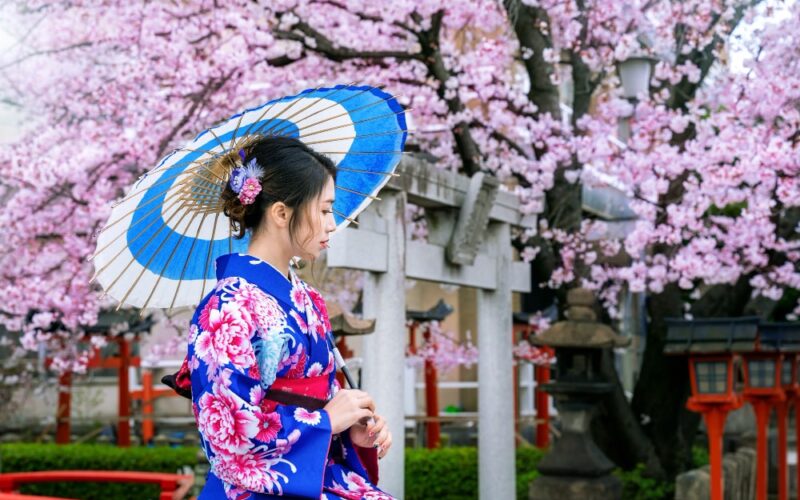The kimono is the most famous traditional culture in Japan. Nowadays, the kimono has become loved by many people all over the world, and more and more foreigners are visiting Japan to wear kimonos. Many Japanese people wear it as a formal piece of clothing. It is difficult to put on, but the Japanese wear it when there is a special event.
The beginning and history of the Kimono
The kimono has a long history, and its origin is said to be over 1,000 years ago. The first modern kimono was worn with a hakama (a type of skirt) or a mo (a type of apron). Then, people started wearing not only hakama but also kimonos. As a result, an obi, a string that wraps around the waist from the top of the clothes, was developed.
Around 1300, the kimono became a part of everyday wear, and many people began to wear multiple layers of clothing. It is said that this was the trigger for deciding the colour combination from the viewpoint of gender, season, and era (Joy, 2021).
When do people wear kimonos?
There are many types of kimonos and opportunities to wear them vary depending on colours, materials and styles. More and more people are becoming interested in Japanese kimono culture, and these days they are popular all over the world (The Japanese Shop Blog., 2022).
Examples of occasions in which kimonos are worn
・Weddings
The bride and the groom wear kimonos at the Shinto wedding ceremony held at the shrine.
Wedding guests also wear kimonos. Participation in a wedding may lead to new encounters. Therefore, it is a rule that young unmarried women wear bright kimonos to catch the eyes of guests, and married and elderly people wear dark colours and simple designs at Japanese weddings (The Japanese Shop Blog., 2022).
・Graduation
At graduation ceremonies, people wear kimonos with hakama.
The hakama is especially popular among women, and most teachers wear hakama at the graduation ceremony (The Japanese Shop Blog., 2022).
・Coming of age ceremony
Adult ceremony is held on the second Monday of January every year. In Japan, one grade is from April 2 to April 1 of the following year, and the adult ceremony is for the celebration of those who are 20 years old during that period. Women mainly wear long-sleeved kimonos called furisode. Some men wear suits, while others are dressed in hakama (The Japanese Shop Blog., 2022).
・Summer festival
There are many festivals in Japan, many of which are held in the summer. Many young women wear yukatas and participate in summer festivals. The yukata is more casual and easier to move than the kimono, and it is one of the staples of Japanese summer festivals for women to wear yukatas. (The Japanese Shop Blog., 2022)
・Funeral
In Japan, it is good manners to wear black clothes at funerals. Therefore, most people wear black kimonos. In addition, there is also a funeral kimono called mourning dress. Ordinary kimonos are dressed so that the right collar is on the left side, but at funerals the opposite is said to be good (The Japanese Shop Blog., 2022).
・Tea ceremony
The tea ceremony is one of the traditional cultures that represent Japan, and refers to a series of processes, such as tea preparation, serving, and completion of appreciation techniques. When doing a tea ceremony, most people mainly wear kimonos with simple designs. Since the culture that was born when the kimono was worn as everyday clothes is the tea ceremony, the movement of making tea and the design of the kimono are often related (The Japanese Shop Blog., 2022).
Types of kimonos
There are various types of kimonos. They have different characteristics and can be used according to purpose.
・Furisode
It is the most formal kimono and has many nice and eye-catching designs. Furisode is classified into three types: Ofurisode, Chu-furisode and Kofurisode, according to the length of the sleeves. (Montald, l., 2022)
・Houmongi
When houmongi is translated into English, it means visiting clothes. There are many types of houmongi, and people wear clothes that match the atmosphere of home parties. Most of the visiting clothes generally have elegant designs (Montald, l., 2022).
・Yukata
The yukata’s fabric is lighter than that of ordinary kimonos, and it is very cool. Most women wear it during festivals as a summer tradition in Japan. The most casual and popular kimono style is the yukata (Montald, l., 2022).
・Wedding kimono
The white kimono worn by the bride is called Shiromuki. By wearing a pure white kimono, the bride’s presence stands out at the reception (Montald, 2022).
・Men’s kimono
Many men’s kimonos are simple and easy to put on. Men’s kimonos consist of mainly hakama (pants) and haori (jacket). (Montald, 2022)
There are many other types, but these are the typical ones that are known and worn by many Japanese people.
Conclusion
The kimono is the most famous and popular Japanese culture, and it is loved by many people all over the world. There are many types, and they are used according to the season and purpose. The kimono is representative of Japan and is a culture that has been passed down for thousands of years. Therefore, we should continue to maintain this tradition.
References
Joy, A., 2021. Culture trip. [online] Available at: <https://theculturetrip.com/asia/japan/articles/a-brief-history-of-the-japanese-kimono/> [Accessed 7 August 2022].
Montald, l., 2022. Know Your Kimono: 9 Different Kimono Types – WAttention.com. [online] WAttention.com. Available at: <https://wattention.com/know-different-kimono-types/> [Accessed 9 August 2022]. The Japanese Shop Blog. 2022. Occasions to Wear a Japanese Kimono | Kimono Occasions. [online] Available at: <https://www.thejapaneseshop.co.uk/blog/7-occasions-wear-japanese-kimono/> [Accessed 9 August 2022].
